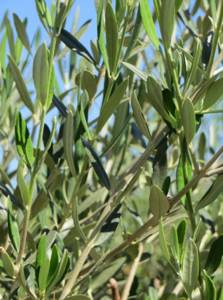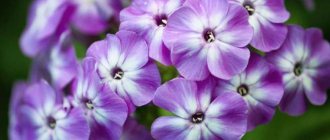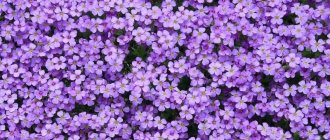The pomegranate tree has been known since ancient times. Pomegranate was brought to Ancient Egypt by the Phoenicians in 825 BC. During the time of the pharaohs, the plant was called the Carthaginian apple. In some countries, the garnet is believed to be the ancestor of the crown, and the ruby color is considered a symbol of power.
Pomegranate tree (pomegranate) is a small plant in the form of a tree or bush from the Derbennikov family. Translated from Latin, the word “pomegranate” means “grainy”. Hence another name for it - granular or seed apple.
Wild plant species are common in subtropical southern Europe and western Asia. Breeders have bred many garden and ornamental pomegranates.
Delicious fruits - pomegranates - are very healthy. Therefore, in an area where it is impossible to grow a subtropical plant in natural conditions, they wondered whether it was possible to grow pomegranate at home.
How to grow pomegranate at home? What conditions are needed for indoor pomegranate to bear fruit? This will be discussed in the article.
Types and varieties of homemade pomegranate
At home, it is common to grow dwarf varieties and species of exotic plants - mini.
- Garnet Baby. The variety is famous for its miniature height: a small bush of homemade pomegranate does not grow more than half a meter. Leaves are elongated. Flowers are collected in inflorescences of several pieces. The fruits are orange-brown.
- Nana. The dwarf pomegranate grows up to one meter and is similar to a garden representative; it has smaller leaves, flowers, and pomegranates.
- Ruby. Indoor pomegranate up to seventy centimeters high. The pomegranate flower is a deep red color – hence its name. The weight of the fruit reaches one hundred grams.
- Uzbekistan. This pomegranate grows up to two meters at home. The spherical fruits are bright red in color, have a sweet and sour taste, and their weight reaches one hundred and twenty grams.
- Carthage is dwarf. A small home tree up to eighty centimeters tall is covered with small leaves, and during the flowering period red flowers with a diameter of 4 cm are added to them. Small juicy fruits have a pleasant sourness.
- Bala-mursal. The Azerbaijani variety grows up to three meters in the garden, and up to one and a half meters in the home environment. The leaves are oblong. The color of the fruits is raspberry, they taste sweet and sour.
If you want to grow common pomegranate at home, you can use not only dwarf varieties. The room conditions do not allow vigorous varieties to grow more than two meters. The most popular types: Shah-nar, Kzyl-anar, Wonderful, Udfi, Purple, Gyuleysha.
Growing pomegranate from seed
Homemade grain apples are sold in stores that sell seedlings and flowers. You can grow pomegranate yourself from a seed or from a cutting. Planting methods depend on which propagation method is chosen.
Pomegranate from seeds is grown at home more often than from cuttings. Seed propagation does not require special skills.
How to grow pomegranate at home? To do this, you must follow several rules.
Seed selection
A ripe, healthy fruit is suitable for choosing pomegranate seeds for planting. It should be remembered that growing indoor pomegranate from seeds taken from fruits purchased on the market will not preserve the taste of the mother pomegranates, because these are hybrids. But the decorative qualities of such a homemade granular plant are high.
A good option would be mature indoor pomegranate varieties. Cream-colored, hard seeds suitable for sowing. The seeds are freed from the pulp. They can also be purchased at retail outlets that sell seeds. Before sowing, the seeds are soaked for 12-20 hours in a mixture of water and growth stimulant. Epin, Kornevin, Zircon are suitable. It is impossible to completely immerse the seed in liquid - it must have access to oxygen.
Pomegranate pests
Aphids and whiteflies. These pests are easy to identify. The leaves become shiny and sticky, which complicates photosynthesis processes and weakens the entire tree. Insects eat leaves. The carriers of aphids are ants.
If there are a small number of insects, they should be removed with your own hands. For example, removing damaged leaves. Mature butterflies can be sucked up with a vacuum cleaner, and larvae and aphids can be defeated by first spraying the crown with a solution of laundry or green soap.
If the disease is too advanced, it is necessary to use specialized drugs, for example: Fitoverm, Karbofos, Iskra. Before carrying out treatment, it is important to cover the soil with plastic film to prevent the poison from getting into groundwater.
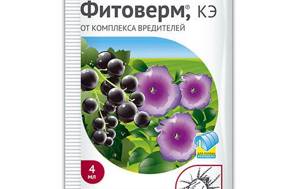
The pomegranate tree is an unusual, exotic plant for the home, surprising every guest. But despite its exoticism, caring for it does not require much money or time, which makes it an excellent window sill resident. The main thing is systematic watering, the required amount of moisture, fertilizers, sunlight, and timely pruning once or twice a year.
An annual transplant will allow it to grow, develop, and become stronger. If you follow all the rules of simple care, the pomegranate will bloom, delighting not only with its appearance and aroma, but also with juicy, bright fruits with a rich taste, which differ from store-bought ones.
Caring for pomegranate at home
Homemade pomegranate cannot be called a capricious plant. Caring for him is simple and not burdensome. But you still have to follow a number of rules.
A pomegranate in a pot feels comfortable if the necessary conditions are created for the home plant. They include the desired temperature, sufficient lighting, optimal levels of watering and humidity, and timely fertilizing.
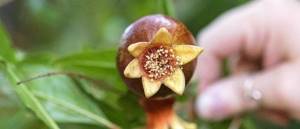
Temperature and lighting
The heat-loving indoor plant feels good during the growing season at temperatures from 25 to 30 degrees. During the dormant period, the house plant is comfortable within the temperature range of 18-25 degrees. The temperature in the room where the homemade grain apple is located should not fall below 12 degrees. If the room is too hot, the pomegranate leaves will begin to wilt and fall off. You can cool your home crop by spraying it with cool water.
Air stagnation is detrimental to houseplants, so the room must be systematically ventilated.
The indoor grainy apple loves light. A southern windowsill is a suitable place for a house plant. At midday, it is better to remove or shade homemade pomegranate from the bright rays of the sun so as not to harm the leaves and buds.
The lack of light in autumn and winter or in cloudy weather is compensated for by phyto lamps. Daylight hours should last about twelve hours. Then the flowering period of indoor pomegranate will continue, it will bear fruit. Otherwise, the house plant will enter a period of hibernation with the loss of some leaves.
Summer outdoor maintenance has a beneficial effect on indoor plants. Only adaptation needs to be carried out gradually, taking the homemade pomegranate outside for two to three hours.
Watering and air humidity
Watering pomegranates at home should be done with a sense of proportion. A well-dried top of the earthen clod will indicate that the grainy plant needs to be watered.
For irrigation you need soft, well-settled water at 25-30 degrees. During dormancy, an adult houseplant is watered once or twice a month, a young one - once every eight to ten days.
The rest period created for the indoor grain plant ends in February. To activate life processes, the soil is moistened abundantly, and by this time the daylight hours increase. Frequent watering is necessary for homemade grain apples until flowering. From late spring to early autumn, when the houseplant blooms, watering is reduced. This is dictated by the laws of wildlife: in its natural environment, the plant blooms during the heat and drought seasons.
Proper care of indoor trees
To maintain an attractive appearance, juiciness, and sweetness of fruits, the plant needs to create a suitable living environment and properly care for it. Each period has its own rules, about which the gardener must be notified in detail.
Spring Summer. It is during this period that pomegranate needs more natural solar radiation, rather than the light that comes from indoor lamps. Many people place the plant on a balcony or loggia to ensure an influx of street air and sunlight. However, you need to be careful: too hot, bright sun will burn the foliage.
It is important to know that the crown should not be sprayed with water before sunbathing, otherwise it will speed up burning. If dust has accumulated on the leaves, it must be removed. This will improve photosynthesis. It is advisable to place the plant on southern, western, eastern window sills - they are most suitable for high-quality development.
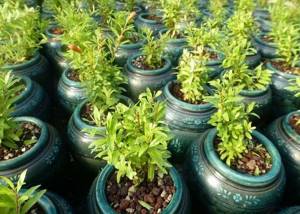
The optimal temperature for growing a grant tree is 20-25 degrees. If the room is hotter, it is worth increasing the amount of water and the frequency of watering. During these periods, it is important to remember to irrigate the soil and crown; this procedure should be regular and abundant. Settled, distilled water will have the most beneficial effect on the plant. Because the more impurities, the worse it is for the plant.
In summer, you need to especially carefully monitor the quality of moisture, because in the summer months this is most important compared to other times of the year. Excessive dryness of the soil has a bad effect on the life of the crop. The tree should be sprayed with extreme care, without flooding it. Excess moisture causes the fruits to crack.
Pomegranate fertilizer
In addition to soil irrigation, it is useful to treat the pomegranate tree with water at room temperature once every 2 weeks with the use of fertilizers. During the stage when the crop bears fruit, it is fed with special fertilizers containing a complex of essential micronutrients and minerals, which have a positive effect on both growth and the amount of vitamins in ripened fruits.
Fertilizers must contain phosphorus, potassium, and nitrogen. Typically, feeding occurs once every 14 days, but can be done once every 10 days - depending on age and living conditions. For pomegranates, Etisso fertilizer is most often used.
It is important to know that this product is divided into two types: for green plants and for plants during flowering periods.
Autumn winter. In autumn, the crop sheds its leaves, so for 2-3 months you need to reduce the amount of watering and place the pot with the plant in a dark, cool room. Before wintering, you need to feed the pomegranate with mullein infusion.
The scheme is simple: 100 grams of cow dung are mixed in one liter of water. Wintering of the plant ends by mid-February; the pot must be placed again in a warm, bright room, increasing the frequency and amount of water poured.
Pruning of fruit crops
Varieties of small pomegranate trees tolerate this manipulation well, so everyone can give the plant the shape they want. The procedure is carried out either at the beginning of March or at the end of November-December. This is explained as follows: when the culture is in a calm state, it rests, the movement of juices is slowed down. This makes pruning less painful.
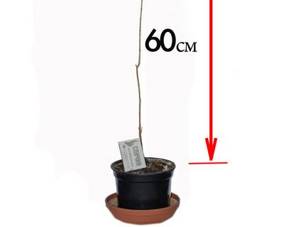
For quality pruning, it is not necessary to involve professional gardeners. It is enough to follow the following rules:
- At the first stage, it is important to cut off all dried branches. This will thin out the crown.
- If the grenade had several barrels, you need to leave only 5.
- A large number of branches from the main trunk should be cut off, i.e., only the fluffy crown should be left where the fruits will ripen. Unnecessary branches drain strength, preventing quality growth.
The peculiarity of pomegranate tree is its resistance to dry air. However, in this situation, the soil of the pot must be kept moist.
Transplanting a plant
Pomegranates need to be replanted annually, especially after five years after planting. Further periods of growth will be the most active. Every year the volume of the pot should increase by at least 100 milliliters, its shape should be elongated.
When the tree grows to an impressive size, replanting will be difficult. Only the surface layer of soil can be replaced.
How to propagate indoor pomegranate
Propagation of pomegranate by cuttings at home is called cuttings.
Indoor tree cuttings are prepared from the current year's shoots or from root shoots. Ten to fifteen centimeters of an indoor plant with four to five buds is enough for cuttings. The cuttings take root successfully and retain the genetic characteristics of the mother.
The cutting is placed in a root growth stimulator for six hours. Then it plunges three centimeters into nutritious loose soil at a slight slope. The greenhouse effect for the future indoor plant is created using a glass jar or polyethylene. The cuttings need to be regularly ventilated, sprayed, and watered. The main thing is not to moisten the soil too much to prevent rotting.
Propagation of pomegranate tree by cuttings
Propagating plants using cuttings is the most common method. With the cutting, all of its genetic material, disease resistance, and harvest quality are transferred to the plant.

To get a good cutting, in the spring you need to select the middle of a 2-year-old branch that already has at least three buds. The length of the branch should be about 15 centimeters. Place it in water for several days to stimulate root growth.
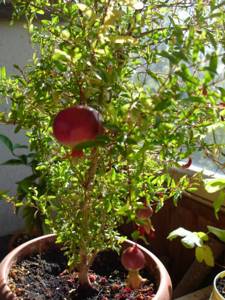
After soaking, the cutting can be planted in the ground, which will be similar to a substrate for seeds. About four weeks after planting in the ground, the cutting should have a root system. After a month, the plant is ready to be transplanted into a larger pot.

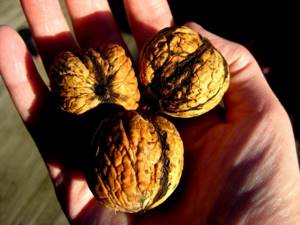
The soil should be sandy for an adult tree. Once it has fully grown and its height is at least 50 centimeters, your pomegranate tree is ready to be planted in open ground or transplanted into a large pot, where it will grow constantly. As you can see, planting a pomegranate tree does not require much effort.

Pests and diseases of pomegranate
Without regular ventilation, in conditions of high humidity, and non-compliance with temperature conditions, homemade granular apples get sick. Most often, a houseplant may suffer from powdery mildew, branch cancer, and leaf spot.
- With powdery mildew, a white coating appears on the leaves. The homemade granular plant must be treated with Topaz, Skor, Hom.
- With branch cancer, cracking of the bark occurs with the formation of swellings. Affected branches are removed.
- When spotted, yellow-brown spots appear on the leaves. The indoor granular plant must be transplanted into new soil, removing rotten roots and treating the entire root system with a solution of potassium permanganate. In the future, avoid excessive watering.
Pests of homemade grain apple: whitefly, aphids, scale insects.
- You can exterminate the whitefly - white midge - with garlic water, prepared from ordinary water and three crushed cloves of garlic, infused for two days. Can be treated with Fitoverm, Aktara.
- You can exterminate aphids - a small green insect - with a solution of liquid soap, followed by washing with running water or Iskra, Tanrek, Strela.
- You can exterminate scale insects - small brown warts on the leaves - using a sponge and soap solution or Aktar, Doctor, Zolotoy Iskra.
Growing the pomegranate fruit tree
This tree can produce a good harvest if grown properly. The main condition is warmth and sufficient light. Pomegranate is propagated by seeds, cuttings and layering. For planting, the seeds that are inside the fruit are used, but they must be prepared before planting. To do this, the seeds are dried within 24 hours and then placed in the refrigerator for 5-6 days.
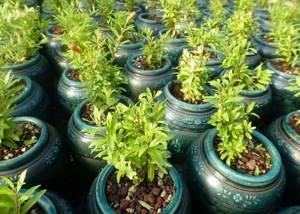
For planting, you can use small pots with ready-made soil, which is used for growing flowers indoors. The pot must have a drainage system. Soil is poured into the pot and watered abundantly. The seed, ready for planting, is placed in this soil to a depth of 1 cm. To speed up the growth process, the pot is covered with plastic wrap and placed in a warm place in the sun. After the sprout appears, the plastic film can be removed. A small but well-established seedling can be planted in the ground.
Planted in the ground in spring or autumn on an area well lit by the sun. By adhering to these recommendations, the pomegranate will develop normally and begin to bloom and bear fruit.
For propagation by cuttings, one-year-old shoots of a healthy tree are used. Before planting, prepare a place for this: fertilize the ground and make sure it warms up well enough. To reliably take root of the cuttings, they are covered with plastic film and slightly shaded so that the cuttings do not overheat and die.
In the first years after planting, the young tree needs watering as the soil dries out. There is no need to overdo it, as the presence of excess moisture can lead to rotting of the root system. In addition, in the tree trunk circle it is necessary to loosen the soil and not forget about feeding the plant if you want to get a good final result. In June, organic fertilizers need to be applied, and closer to autumn, potassium and phosphorus fertilizers are applied. To obtain a good harvest and proper crown formation, it is necessary to constantly trim the pomegranate.

Before the onset of cold weather, pomegranate produces buds for the future harvest. So that the work does not go to waste, the tree is protected from cold and frost by covering it with any suitable material. The remaining buds will bloom in the spring along with the leaves. Pomegranate begins to bloom in the 2nd-3rd year of life, and bear fruit in the 4th year.
Possible problems (turns yellow, dries, falls off)
- The houseplant turns yellow. The cause may be insect pests or high temperature.
- The houseplant is drying up. The cause may be too dry air or root disease from improper watering.
- The houseplant falls over. The reason may be preparation for a dormant period, insufficient watering, high temperature, or insect pests.
The listed reasons will also tell you why pomegranate does not bloom.
A fruit garden in an apartment can be created using dwarf varieties of home pomegranate - a beautiful exotic tree that will delight its owners with a spectacular appearance and healthy fruits.
